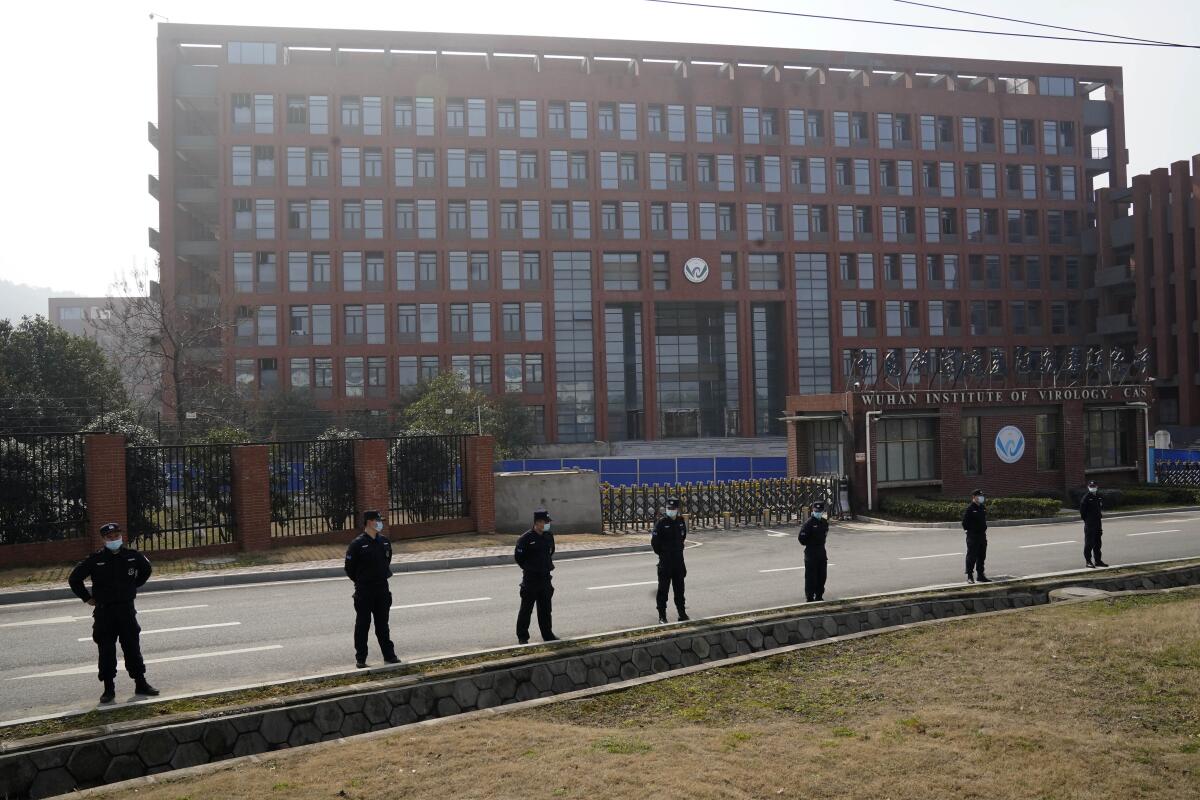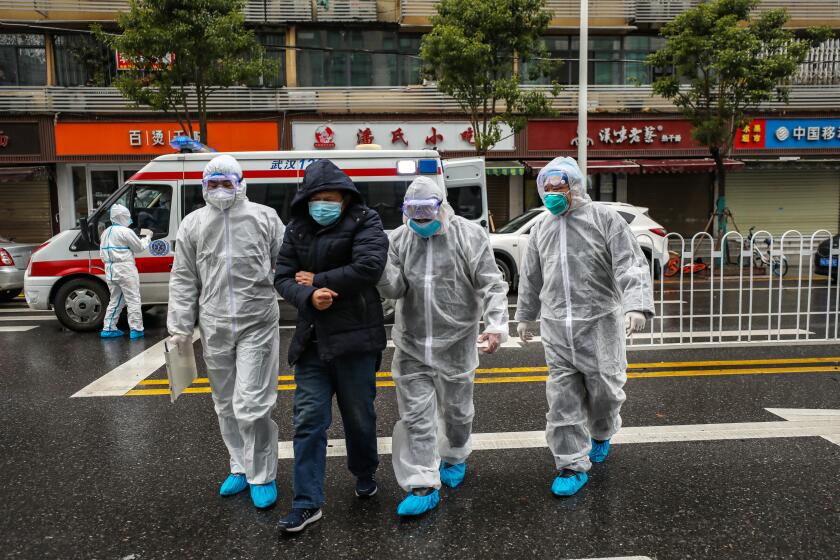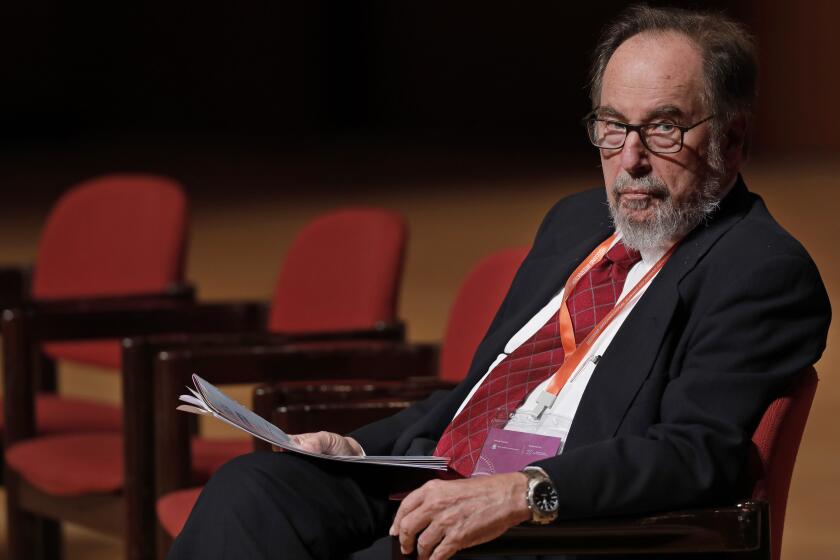ProPublica and Vanity Fair are pushing the COVID lab-leak theory, but their exposé is a train wreck

- Share via
Since its founding in 2007, the independently funded investigative organization ProPublica has exposed wrongdoing at all levels of government and shined a light on corporate misbehavior, collecting six Pulitzer Prizes in the process and securing a reputation for painstaking, accurate journalism.
An article that ProPublica published Friday, pushing the claim that COVID-19 escaped from a Chinese virus lab before going on to infect the world, doesn’t fall into that category.
It is, to be charitable, a train wreck.
Anyone claiming they alone can understand a language spoken by 1/5 of the species is selling you something.
— China expert Brendan O’Kane, challenging a new claim about COVID’s origins
The article is based heavily on Chinese-language documents that appear to have been mistranslated and misinterpreted, according to Chinese language experts who have piled on via social media since its publication.
It also takes as gospel a report by a rump group of Republican congressional staff members asserting that the pandemic was “more likely than not, the result of a research-related incident.”
Get the latest from Michael Hiltzik
Commentary on economics and more from a Pulitzer Prize winner.
You may occasionally receive promotional content from the Los Angeles Times.
That conclusion runs exactly counter to the overwhelming weight of opinion among scientists in the fields of virology and evolutionary biology.
The scientists conclude that COVID reached humans via zoonotic pathways, that is, directly from an animal host or hosts. Their conclusion is that the spillover was centered on the Huanan seafood market in Wuhan, China, where animals susceptible to COVID infection were for sale.
As a team of 18 scientists reported in a paper in Science on July 26, “our analyses indicate that the emergence of SARS-CoV-2 [the virus that causes COVID-19] occurred through the live wildlife trade in China and show that the Huanan market was the epicenter of the COVID-19 pandemic.”
A companion paper with 29 authors published simultaneously by Science provides further circumstantial evidence pointing to the Huanan market as the site of at least two zoonotic events.
By contrast, there is no evidence that COVID escaped from the Chinese lab — none, only innuendo and claims by data crunchers with no expertise in the relevant scientific fields.
A new study supports the scientific consensus that COVID-19 reached humans from the animal kingdom, not a Chinese laboratory.
You wouldn’t know that from reading the ProPublica/Vanity Fair article. The article asserts the existence of “a bitter battle ... between a group of virologists who assert their research points to a market origin and an alternate group of academics and online sleuths who argue there’s been an attempted coverup of a more likely lab origin.”
The editors and authors of the ProPublica/Vanity Fair article didn’t seem to notice the mismatch in expertise between the proponents of these theories: On the one hand, virologists and biologists publishing in peer-reviewed journals; on the other, “academics and online sleuths.” (Those “academics” tend to work in fields other than virology or evolutionary biology.)
There’s reason to be concerned about the promotion of an unproven theory about COVID’s origins. The attention devoted to the claim that a Chinese virus lab was responsible diverts remedial efforts from the proper target for regulation, which is overly loose regulation of contacts between humans and disease-carrying wildlife.
Another point of concern is the performance of ProPublica. Its cadre of first-rate reporters and editors has worked hard to acquire the credibility and respect it holds among journalists and readers. But it doesn’t take much to shatter one’s credibility.
ProPublica appeared to place its reputation at stake with an article that elevates a partisan view of a public health crisis over the work of experienced scientists. That’s not what one has come to expect from the organization.
The article makes scant reference to the scientific consensus, beyond quoting University of Arizona evolutionary biologist Michael Worobey, the lead author of one of the Science papers.
Worobey has publicly challenged the ProPublica/Vanity Fair article’s description of his work in a lengthy Twitter thread in which he published a memo he wrote to the authors before their publication. In the memo, he cautioned the authors about what he termed erroneous assumptions they were making about his and others’ research.
In ‘Viral: The Search for the Origin of COVID-19,’ Alina Chan and Matt Ridley ignore scientific consensus in favor of specious, dangerous guesswork.
The article does have an “expert” to offer, however. He’s Toy Reid, who is supposedly fluent in Chinese and has worked on China issues for Sen. Marco Rubio (R-Fla.), according to the article.
The article describes Reid as a researcher who somehow was uniquely able to decipher Chinese-language dispatches on the website of the Wuhan Institute of Virology whose “meaning can’t be unlocked by just anyone.” The article asserts that “using his hard-earned expertise, Reid believes he unearthed secrets that were hiding in plain sight.”
The purported “secrets” were that the Wuhan lab struggled to maintain biosafety standards and experienced a safety crisis in late November 2019, around the time of the first known outbreak of COVID-19.
Let’s pinpoint some of the problems with the ProPublica/Vanity Fair article.
The article rests on two pillars. One is Reid’s translations and interpretations from the Wuhan Institute website. The other is the Republican committee report. We’ll take them in order.
Reid claims in the article to have figured out how to interpret the “party speak” practiced by Chinese Communist officials. Reid describes party speak as “its own lexicon.” The article quotes him as saying that even a native Mandarin speaker “can’t really follow it.”
Mandarin speakers, native and otherwise, beg to differ.
Brendan O’Kane, a Chinese translator who says he has been contacted for help by one of the authors since the article’s publication, says on Twitter that “reading Party-speak is a specialized skill but not a rare one. Anyone claiming they alone can understand a language spoken by 1/5 of the species is selling you something.”
Jane Qiu, a molecular biologist and science writer working in Beijing, says that Reid’s failure to understand the tense of a line in a key Chinese document misled him into describing a safety concern at the Wuhan Institute as occurring around the time of COVID’s appearance.
In fact, she says, it was a generic reference to work on safety standards closer to the time of the institute’s founding. She also says that he apparently missed a line in the same document stating that the safety concerns were resolved.
For months, adherents of the theory that COVID-19 originated in a Chinese government laboratory have hoped that an assessment President Biden ordered from the nation’s intelligence agencies would validate their suspicions. Their hopes are now dashed.
Others have questioned Reid’s claim to have read “between the lines” of the Chinese dispatches. “One should get the lines themselves correct first,” observed Zhihua Chen, a China-born data scientist, also on Twitter. In this case, he says, Reid mistranslated a key sentence.
ProPublica, its managing editor, Tracy Weber, and Katherine Eban, one of the authors, haven’t responded directly to my requests for comment. A weirdly feeble joint response from Vanity Fair and ProPublica sent me by Rachel Janc, a Vanity Fair publicist, says the Chinese postings “are often opaque and open to varying interpretations.” The statement says, “We are continuing to report on questions raised online about how the committee characterized those postings and will update our story as needed.”
As of this writing, no updates appear on the story other than a minor clarification related to Worobey, posted the same day the story was published.
As for the Senate committee report, it’s proper to place it in the context of the original inception of the lab-leak hypothesis in partisan politics.
I’ve reported before that it was initially championed in 2020 by ideologues in the State Department under then-President Trump. For them, blaming a pandemic on the Chinese government and its laboratories served the dual purposes of scoring points against a geopolitical adversary and distracting attention from the Trump administration’s incompetent response to the pandemic.
In its original form, the theory held that the Chinese deliberately created the virus as a biological weapon. It evolved into a claim that the virus originated in experiments to enhance the infectivity of microbes being studied in the lab and ultimately to the proposition that researchers at the institute unwittingly became infected while doing fieldwork and carried the virus into the institute.
No evidence whatsoever has ever been produced for any of these theories. All that remains is an argument based on unsupported conjecture and the absence of evidence: Why don’t we know more about the work at the Wuhan Institute, unless the Chinese government is hiding its guilt?
Blaming the Chinese government for the pandemic has remained the one unchanging element of the hypotheses, with a specific focus on the Wuhan Institute, which is nearly 10 miles and across a river from the seafood market in a teeming metropolis of about 8.6 million — about the size of New York City — with extensive regional transport links.
Hiltzik: A Nobel laureate backs off from claiming a ‘smoking gun’ for the COVID-19 lab-leak theory
David Baltimore was quoted as finding a ‘smoking gun’ for the lab-leak theory of COVID-19’s origins. He wishes he hadn’t said that.
At least one of the early Trump-era advocates for the lab leak theory resurfaces in the ProPublica/Vanity Fair article, quoted as suggesting that the Chinese Communist Party deliberately obscured the existence of a safety crisis at the time of the COVID outbreak. He’s Matthew Pottinger, a deputy national security advisor under Trump now at the conservative Hoover Institution.
Pottinger has been a source for Katherine Eban, one of the authors of the article, in at least three previous articles in Vanity Fair, including two in which he attacks the Wuhan lab.
The new report from the Republican minority on the Senate Committee on Health, Education, Labor and Pensions is essentially a warmed-over presentation of the usual lab-leak claims.
It asserts that “substantial evidence demonstrating that the COVID-19 pandemic was the result of a research-related incident has emerged” but doesn’t present anything but suppositions based on findings that the Wuhan lab upgraded its safety equipment and held safety training sessions in 2019.
Angela Rasmussen of the University of Saskatchewan, a co-author of Worobey’s Science paper, describes those steps as “normal” for any bioscience lab handling dangerous pathogens — regular and proactive renovations.
Rasmussen observes that in referring to the Wuhan lab, the Senate Republican report offers “no evidence of a breach or biosafety failure, but lots of evidence that they were operating a containment lab in a pretty standard way, with one exception: WIV was more innovative than many others.”
ProPublica and Vanity Fair published a towering assertion about sinister doings at a Chinese research lab without offering a scintilla of evidence. They placed their credibility at the service of an overtly partisan and ideological claim and presented it, again without foundation, as though it’s more credible than actual scientific findings about how the COVID pandemic came to be. It’s a shameful performance.
More to Read
Get the latest from Michael Hiltzik
Commentary on economics and more from a Pulitzer Prize winner.
You may occasionally receive promotional content from the Los Angeles Times.














